Gulf Coast of the United States
Gulf Coast | |
|---|---|
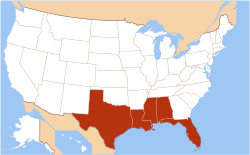 States that border the Gulf of Mexico are shown in red. | |
| Country | |
| States | |
| Principal cities | Houston Tampa Mobile New Orleans Pensacola Gulfport Tallahassee |
| Largest city | Houston |
| Largest metropolitan area | Greater Houston |
| Population | |
| • Total | 64,008,345[1] |
The Gulf Coast of the United States, also known as the Gulf South or the South Coast, is the
The economy of the Gulf Coast area is dominated by industries related to energy, petrochemicals, fishing, aerospace, agriculture, and tourism. The large cities of the region are (from west to east) Brownsville, Corpus Christi, Houston, Galveston, Beaumont, Lake Charles, Lafayette, Baton Rouge, New Orleans, Gulfport, Biloxi, Mobile, Pensacola, Panama City, St. Petersburg, and Tampa. All are the centers or major cities of their respective metropolitan areas and many of which contain large ports.
Geography

The Gulf Coast is made of many
Climate
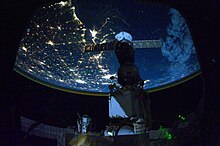
The Gulf Coast climate is humid subtropical, although
This pattern is evident in southern cites as
Rising sea levels
Due to the release of greenhouse gas emissions, glaciers and ice sheets are melting and expanding the oceans. The United States coastlines are projected to rise 1 foot in three decades or between 10 and 12 inches on average by 2050.[6] The Gulf Coast will likely see the biggest change, with sea levels expected to rise between 14 and 18 inches. The Global and Regional Sea Level Rise Report predicted more frequent, major and destructive high tide flooding events along with taller storm surges by 2050 after scientists determined high tide flooding has been "increasingly common" over the past few years due to the rising sea levels.[6] The impacts are expected to be dramatic. Low-lying coastal areas are expected to experience multiple factors, including increased levels of flooding, accelerated erosion, loss of wetlands and low-lying terrestrial ecosystems, and seawater intrusion into freshwater sources. Rising sea level and erosion will also imperil critical habitats for many commercially important fisheries that depend on inshore waters for either permanent residence or nursery area.[7] In 2021 alone rising sea levels cost the United States approximately $2.6 billion in relief efforts and caused at least seven deaths.[6] By 2051, the cost of flood damage is expected to increase by 61%, or $32 billion.[8]
Economic activities
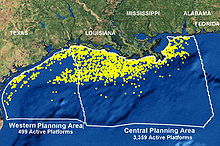
The Gulf Coast is a major center of economic activity. The marshlands along the Louisiana and Texas coasts provide breeding grounds and nurseries for ocean life that drive the
The discovery of oil and gas deposits along the coast and offshore, combined with easy access to shipping, have made the Gulf Coast the heart of the U.S. petrochemical industry. The coast contains nearly 4,000 oil platforms.
Besides the above, the region features other important industries including aerospace and biomedical research, as well as older industries such as agriculture and — especially since the development of the Gulf Coast beginning in the 1920s and the increase in wealth throughout the United States — tourism.
History
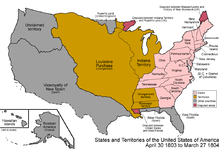
Before European settlers arrived in the region, the Gulf Coast was home to several pre-Columbian kingdoms which had extensive trade networks with empires such as the Aztecs and the Mississippi Mound Builders. Shark and alligator teeth and shells from the Gulf have been found as far north as Ohio, in the mounds of the Hopewell culture.[12]
The first Europeans to settle the Gulf Coast were primarily the
Two major events were turning points in the earlier history of the Gulf Coast region. The first was the

Since then the Gulf Coast has been hit with numerous other hurricanes. On August 29, 2005,
Other than the hurricanes, the Gulf Coast has redeveloped dramatically over the course of the 20th century. The gulf coast is highly populated. The petrochemical industry, launched with the major discoveries of oil in Texas and spurred on by further discoveries in the Gulf waters, has been a vehicle for development in the central and western Gulf which has spawned development on a variety of fronts in these regions.
Metropolitan areas
The following table lists the 11 largest core-based statistical areas along the Gulf Coast.
| Rank | Metropolitan statistical area | 2020 pop. (est.) |
|---|---|---|
| 1 | Houston-The Woodlands, TX Combined Statistical Area | 7,340,823 |
| 2 | Tampa-St. Petersburg-Clearwater, FL Metropolitan Statistical Area
|
3,243,963 |
| 3 | New Orleans-Metairie-Hammond, LA-MS Combined Statistical Area
|
1,510,672 |
| 4 | Cape Coral-Fort Myers-Naples, FL Combined Statistical Area
|
1,226,553 |
| 5 | North Port-Sarasota, FL Combined Statistical Area
|
1,087,915 |
| 6 | McAllen-Edinburg, TX Combined Statistical Area
|
939,466 |
| 7 | Baton Rouge, LA Metropolitan Statistical Area
|
858,571 |
| 8 | Mobile-Daphne-Fairhope, AL Combined Statistical Area
|
661,964 |
| 9 | Lafayette-Opelousas-Morgan City, LA Combined Statistical Area
|
619,529 |
| 10 | Pensacola-Ferry Pass, FL-AL Combined Statistical Area
|
547,784 |
| 11 | Corpus Christi-Kingsville-Alice, TX Combined Statistical Area
|
536,258 |
Transportation
Road
Major Interstates
| Highway | Significant cities served |
|---|---|
| Harlingen, McAllen | |
| Tampa | |
| Houston, Baytown, Beaumont, Lake Charles, Lafayette, Baton Rouge, New Orleans, Slidell, Gulfport, Biloxi, Mobile, Pensacola | |
| Baton Rouge, Hammond, Slidell | |
| Corpus Christi | |
| Galveston, Houston | |
Interstate 49
|
New Orleans (future), Houma (future), Thibodaux (future), Lafayette |
Interstate 55
|
Hammond |
Interstate 59
|
Slidell |
Interstate 65
|
Mobile |
Interstate 69
|
Victoria (future), Houston |
| Brownsville, Harlingen, Corpus Christi, Victoria (future) | |
| Victoria (future) | |
Interstate 75
|
Tampa
|
Major U.S. routes
| Highway | Significant cities served |
|---|---|
| New Orleans | |
| Punta Gorda | |
Tampa
| |
| Pensacola | |
| Spanish Fort | |
Tampa
| |
U.S. 43
|
Mobile |
U.S. 45
|
Mobile |
U.S. 49
|
Biloxi, Gulfport |
U.S. 51
|
Hammond |
U.S. 59
|
Houston, Victoria |
U.S. 61
|
New Orleans |
U.S. 69
|
Beaumont, Port Arthur |
U.S. 77
|
Brownsville, Corpus Christi, Harlingen, Victoria |
U.S. 83
|
Brownsville, Harlingen |
U.S. 87
|
Port Lavaca, Victoria |
| Beaumont, Biloxi, Crestview, Houma, Houston, Lafayette, Lake Charles, Mobile, New Orleans, Pascagoula, Pensacola, Thibodaux | |
Tampa
| |
| Beaumont, Port Arthur | |
| Fort Walton Beach, Mobile, Pensacola, Panama City |
Other significant routes
| Highway | Significant cities served |
|---|---|
| Grand Isle, Port Fourchon, Thibodaux | |
| Crestview, Fort Walton Beach | |
| Houston, Bay City, Port Lavaca, Rockport, Corpus Christi | |
| Houston, Lake Jackson, Freeport |
Air
International service

International destinations
George Bush Intercontinental Airport - Houston
|
|
| Louis Armstrong New Orleans International Airport | |
| Southwest Florida International Airport | |
| Tampa International Airport | Bahamas,
|
| William P. Hobby Airport - Houston |
Rail
Amtrak service
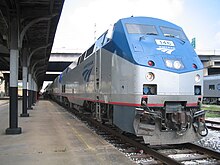
| Train | Route | Gulf Coast cities served |
|---|---|---|
City of New Orleans
|
Chicago to New Orleans | New Orleans |
Crescent
|
New York City to New Orleans | Slidell, LA
|
| Silver Star | New York City to Miami | Fort Myers, FL
|
| Sunset Limited | Orlando (temporarily New Orleans )
|
Pensacola, FL
|
See also
- East Coast of the United States
- West Coast of the United States
- Emerald Coast
- Florida Panhandle
- Geography of the United States
- Gulf Coast Ecosystem Restoration Task Force
- Gulf States Marine Fisheries Commission
- Houston
- List of ports in the United States
- Megaregions of the United States
- Mississippi Gulf Coast
- New Orleans
- Tampa
- West Florida
- Gulf Coast of Mexico
Notes
- ^ "Gulf States 2020". Retrieved April 12, 2020.
- ^ For example: "Gulf Coast Energy Outlook" (PDF) (Spring 2017 ed.). Center for Energy Studies. Archived from the original (PDF) on April 14, 2018. Retrieved April 13, 2018 – via Economics & Policy Research Group., p. 1 (" Unless stated otherwise, Gulf Coast hereafter specifically refers to the states of Texas, Louisiana, Mississippi, Alabama, and Florida").
- ^ "Gulf Coast Wetlands Rapidly Declining • The National Wildlife Federation Blog". The National Wildlife Federation Blog. January 8, 2014. Retrieved March 4, 2021.
- ^ See "Projected change in U.S. hurricane risk based on Risk Analysis Framework for Tropical Cyclones (RAFT)." Fig. 1 op cit
- ^ Karthik Balaguru et al. , "Increased U.S. coastal hurricane risk under climate change." Science Advances. 9,(2023). 14. DOI:10.1126/sciadv.adf0259. Science.org website Retrieved 17 Aug 2023.
- ^ a b c B. Powell, Tori (February 19, 2022). "Sea levels along U.S. coastlines to rise more than a foot by 2050, study projects". CBS News. Retrieved August 30, 2023.
- ^ "Predicting Impacts of Sea Level Rise in the Northern Gulf of Mexico". coastalscience.noaa.gov. Retrieved August 30, 2023.
- ^ Jacobo, Julia (February 22, 2021). "Climate change, rising sea levels to increase cost of flood damage by $34 billion in coming decades: Report". ABC News. Retrieved August 30, 2023.
- ^ Rosenberg, Matt (June 14, 2003). "Busiest Ports in the World". Retrieved October 15, 2006.
- ^ Rosenberg, Matt (June 14, 2003). "Waterborne Commerce Statistics: Tonnage for Selected U.S. Ports in 2004". Archived from the original on November 17, 2006. Retrieved October 15, 2006.
- ISBN 9780759123229.
- ^ Nash, Gary B. Red, White and Black: The Peoples of Early North America Los Angeles 2015 p. 6
- ^ "The 1900 Storm". Archived from the original on July 11, 2006. Retrieved July 11, 2006.
- ^ "Galveston, Texas History". Galveston.com. Retrieved October 15, 2007.
- ^ "Evacuation and Devastation in Southern Texas". The Boston Globe. Retrieved March 28, 2014.
- ^ "Flooding in Miss. and FL". USA Today. September 11, 2008. Retrieved March 28, 2014.
- ^ "Ike missing". www.cnn.com. Retrieved January 14, 2020.
- ^ Robbie Berg (January 23, 2009). "Hurricane Ike Tropical Cyclone Report" (PDF). NHC. Retrieved September 12, 2009.
- ^ Ike Evacuation and Rescue Operation Archived 2013-12-02 at the Wayback Machine
Further reading
- Drescher, Christopher F., Stefan E. Schulenberg, and C. Veronica Smith. "The Deepwater Horizon Oil Spill and the Mississippi Gulf Coast: Mental health in the context of a technological disaster." American Journal of Orthopsychiatry 84.2 (2014): 142.
- Smith, F. Todd Louisiana and the Gulf South Frontier, 1500–1821 (Louisiana State University Press; 2014) 304 pages
- Williamson, James M., and John L. Pender. "Economic Stimulus and the Tax Code The Impact of the Gulf Opportunity Zone." Public Finance Review (2014): 1091142114557724.
External links
- "Map of the Gulf Coast from Florida to Mexico" from 1639 via the World Digital Library
